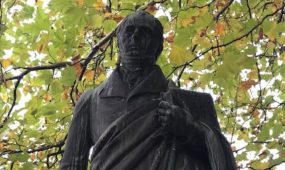My song is love unknown
Hymns
Scott Malcolmson reviews this big, beautiful late Lenten season hymn, which was written during a lunch by a controversial priest: “From the beginning, we find that this is a love song—sung to the Saviour who demonstrated pure love, even to the “love-less” so that they might be “love-ly”

“My song is love unknown,
My Savior’s love to me,
Love to the loveless shown,
That they might lovely be.
O who am I,
That for my sake
My Lord should take
Frail flesh, and die?”
My song is love unknown is a big song with an attractive tune (Love unknown) by the notable English composer John Ireland. The story goes that he composed it over lunch one day in 1918 while out with the organist and music editor, Geoffrey Shaw. Shaw was looking for a tune to go with the hymn, which he wished to include in The Public School Hymn Book of 1919.
The words are by Samuel Crossman (1624-1683) who became Dean of Bristol Cathedral. He received a Bachelor of Divinity at Pembroke College, Cambridge. He then served both an Anglican parish at All Saints, Sudbury, and a Puritan congregation.
Crossman sympathised with the Puritan cause as a dissenting religious body within the context of the Anglican Church of England. He participated in the 1661 Savoy Conference, which attempted to revise the Book of Common Prayer so that it could serve both Puritans and Anglicans.
The Conference was unsuccessful, and the 1662 Act of Uniformity expelled some 2,000 Anglican ministers, including Crossman. He recanted and was soon ordained in 1665, becoming a royal chaplain. He was called to a position in Bristol in 1667 and became Dean of Bristol Cathedral in 1683.
This poignant meditation of the Passion of Christ was published just before Crossman’s ordination, in The Young Man’s Meditation (1664).
This short book of poems was reprinted in 1683, and the poem appeared for the first time as a hymn in the Anglican Hymn Book in 1686, just two years after the author’s death.
Advertisement
The original poem has seven stanzas, taking the singer from Palm Sunday through the crucifixion. It re-tells the story of Jesus’ life (drawing mainly from the Gospel of Matthew, for example Matthew: 27) from a highly personal point of view – as if the singer were witnessing the events at first hand.
There is an almost conversational quality about the second half of some of the verses, with their short halting phrases that the tune reinforces: “But O my Friend, / my Friend indeed…” (v.2); “What may I say? / Heaven was his home…” (v.6). The tune also draws out the underlying grief of the meditation, which is only resolved, in the final verse, by the opportunity to live in uninterrupted relationship with “my Friend”: “This is my Friend, / in whose sweet praise / I all my days / could gladly spend.”
But its purpose is not simply to retell the events of the Passion. From the beginning, we find that this is a love song—sung to the Saviour who demonstrated pure love, even to the “love-less” so that they might be “love-ly”.
The poet freely inserts his own perspective into the story:
“But oh, my friend,
My friend indeed,
Who at my need
His life did spend.” [Stanza two]
The final stanza continues the metaphor of song introduced in stanza one:
Advertisement
“Here might I stay and sing,
No story so divine;
Never was love, dear King,
Never was grief like Thine!
This is my Friend,
In whose sweet praise
I all my days
Could gladly spend.”
The powerful use of irony comes into play in the original stanza four, which begins with two questions: “Why, what hath my Lord done? What makes this rage and spite?” His only crime was that he healed those in need—“He made the lame to run” and “gave the blind their sight.”
In stanza five of the original, the ultimate paradox comes into play: The King, the Lord, the “Prince of Life” becomes a powerless victim in death.
Those who can locate the original poem online will find it is one of the finest devotional poems in helping us meditate on the Passion.





